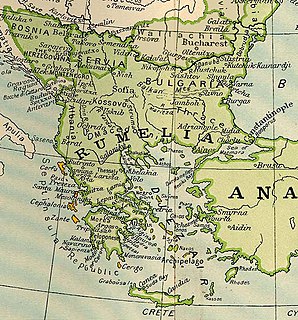
Rumelia, also known as Turkey in Europe, was the name of a historical region in Southeast Europe that was administered by the Ottoman Empire, mainly the Balkan Peninsula. Rumelia included the provinces of Thrace, Macedonia and Moesia, today's Bulgaria and Turkish Thrace, bounded to the north by the rivers Sava and Danube, west by the Adriatic coast, and south by the Morea. Owing to administrative changes between 1870 and 1875, the name ceased to correspond to any political division. Eastern Rumelia was constituted as an autonomous province of the Ottoman Empire by the Treaty of Berlin in 1878. Today, in Turkey, the word Trakya (Thrace) has mostly replaced Rumeli (Rumelia) when referring to the part of Turkey which is in Europe, though Rumelia remains in use in some historical contexts.
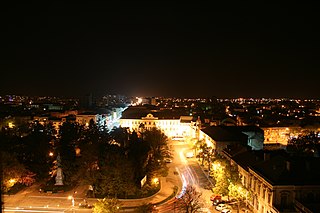
Brăila is a city in Muntenia, eastern Romania, a port on the Danube and the capital of Brăila County. The Sud-Est Regional Development Agency is located in Brăila.
The history of the military of the Ottoman Empire can be divided in five main periods. The foundation era covers the years between 1300 and 1453, the classical period covers the years between 1451 and 1606, the reformation period covers the years between 1606 and 1826, the modernisation period covers the years between 1826 and 1858 and decline period covers the years between 1861 and 1918.
The yatagan or yataghan is a type of Ottoman knife or short sabre used from the mid-16th to late 19th centuries. The yatagan was extensively used in Ottoman Turkey and in areas under immediate Ottoman influence, such as the Balkans and the Caucasus.

A kilij is a type of one-handed, single-edged and moderately curved saber used by the Uyghur Khaganate, Seljuk Empire, Timurid Empire, Mamluk Empire, Ottoman Empire, and the later Turkic Khanates of Central Asia and Eurasian steppes. These blades evolved from Turko-Mongol sabers that had been used over all the lands invaded or influenced by the Turkic peoples.

Uşak carpets, Ushak carpets or Oushak Carpets are Turkish carpets that use a particular family of designs, called by convention after the city of Uşak, Turkey – one of the larger towns in Western Anatolia, which was a major center of rug production from the early days of the Ottoman Empire, into the early 20th century.

A dragoman was an interpreter, translator, and official guide between Turkish, Arabic, and Persian-speaking countries and polities of the Middle East and European embassies, consulates, vice-consulates and trading posts. A dragoman had to have a knowledge of Arabic, Persian, Turkish, and European languages.
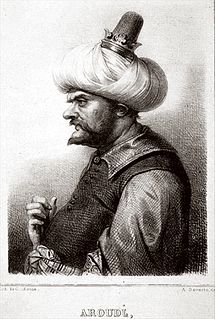
Oruç Reis was an Ottoman bey (governor) of Algiers and beylerbey of the West Mediterranean, and the elder brother of Hayreddin Barbarossa. He was born on the Ottoman island of Midilli and was killed in battle against the Spanish at Tlemcen in the Ottoman Eyalet of Algeria.

Yalova is a city located in northwestern Turkey, near the eastern coast of the Sea of Marmara. Yalova has a city population of 100,863, while the population of Yalova Province is 118,998 as of 2011. Currently there is a controversy around the municipal election results in Yalova especially after the Supreme Election Board invalidated the 2014 Municipal Election results on April 24, 2014 after a few recounts that changed results.

Turkish Kurdistan or Northern Kurdistan is the portion of Turkey, located in the Eastern Anatolia and Southeastern Anatolia regions, where Kurds form the predominant ethnic group.

The Imperial Harem of the Ottoman Empire was the Ottoman sultan's harem composed of the wives, servants, female relatives, and the sultan's concubines, occupying a secluded portion of the Ottoman imperial household. This institution played an important social function within the Ottoman court, and demonstrated considerable political authority in Ottoman affairs, especially during the long period known as the Sultanate of Women. The utmost authority in the Imperial Harem was the Valide Sultan, who ruled over the other women in the household and was often of slave origin herself. The Kizlar Agha was the head of the eunuchs responsible for guarding the Imperial Harem.
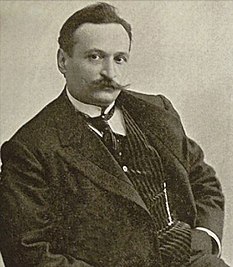
Tevfik Fikret was the pseudonym of Mehmed Tevfik, an Ottoman educator and poet, who is considered the founder of the modern school of Turkish poetry.
Kouloughlis, also spelled Koulouglis, Cologhlis and Qulaughlis was a term used during the Ottoman period to designate the mixed offspring of Turkish men and local North African women, situated in the western and central coastal regions in the Barbary coast. Whilst the terminology was commonly used in Ottoman Algeria, Ottoman Libya, and Ottoman Tunisia, it was not used in Ottoman Egypt to refer to Turco-Egyptians. Today, the descendants of the Kouloughlis have largely integrated into their local societies after independence, however, they still maintain some of their cultural traditions ; they also continue to practice the Hanafi school of Islam, and uphold their Turkish origin surnames.
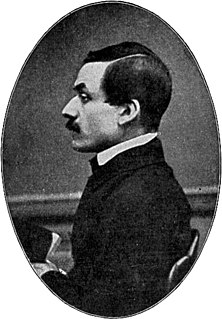
İbrahim Şinasi was a pioneering Ottoman intellectual, author, journalist, translator, playwright, and newspaper editor. He was the innovator of several fields: he wrote one of the earliest examples of an Ottoman play, he encouraged the trend of translating poetry from French into Turkish, he simplified the script used for writing the Ottoman Turkish language, and he was one of the first of the Ottoman writers to write specifically for the broader public. Şinasi used his newspapers, Tercüman-ı Ahvâl and Tasvir-i Efkâr, to promote the proliferation of European Enlightenment ideals during the Tanzimat period, and he made the education of the literate Ottoman public his personal vocation. Though many of Şinasi's projects were incomplete at the time of his death, "he was at the forefront of a number of fields and put his stamp on the development of each field so long as it contained unsolved problems."
Old Anatolian Turkish is the stage in the history of the Turkish language spoken in Anatolia from the 11th to 15th centuries. It developed into Early Ottoman Turkish. It was written in the Arabic script. Unlike in later Ottoman Turkish, short-vowel diacritics were used.
The Metropolis of Nicomedia was an ecclesiastical territory (metropolis) of the Ecumenical Patriarchate of Constantinople in northwestern Asia Minor, modern Turkey. Christianity spread in Nicomedia already in the 1st century AD. Following the capture of the city by the Ottoman Turks in the early 14th century, the metropolitan see remained for a period vacant. The metropolis was re-established during the 15th century and remained active until the Greek-Turkish population exchange of 1922–1923.













